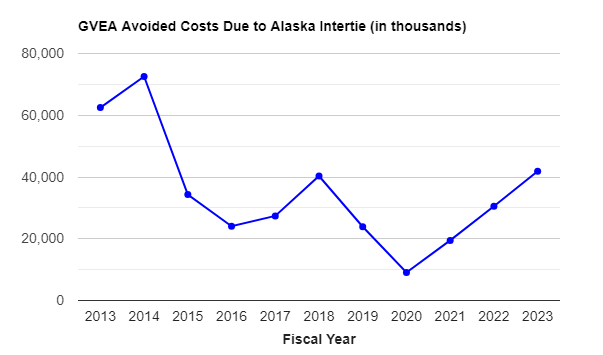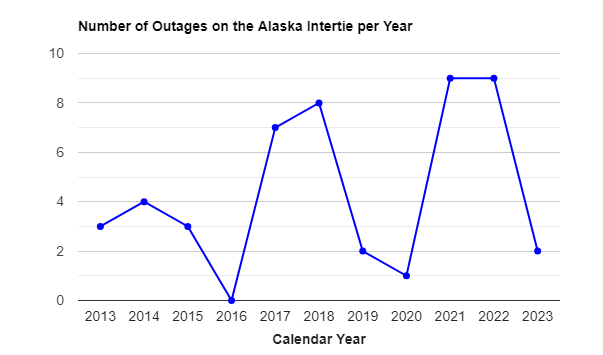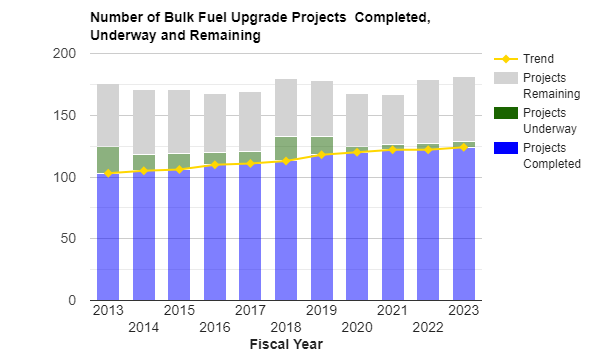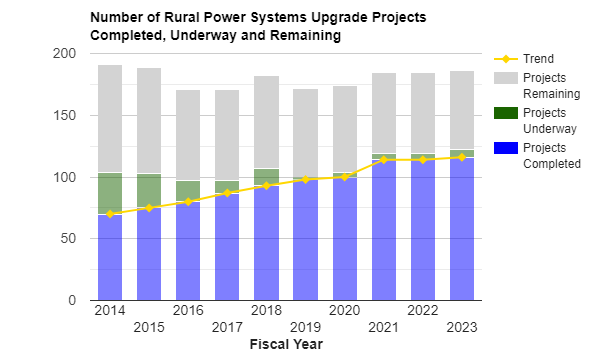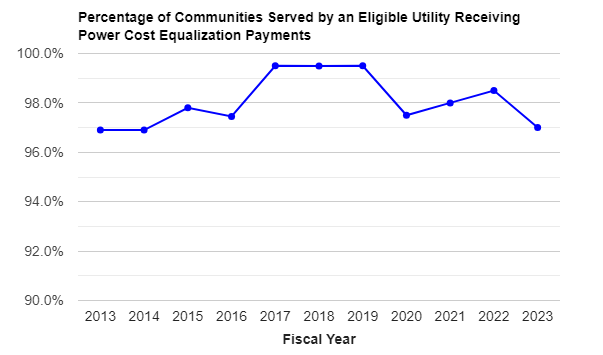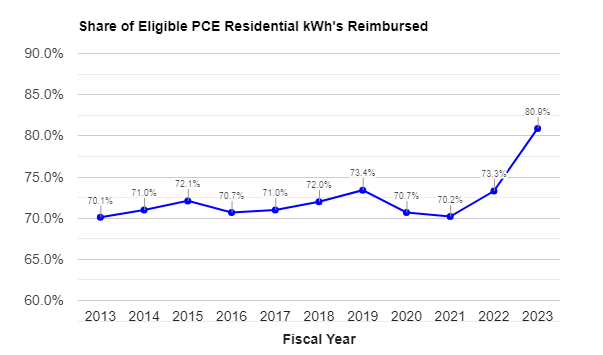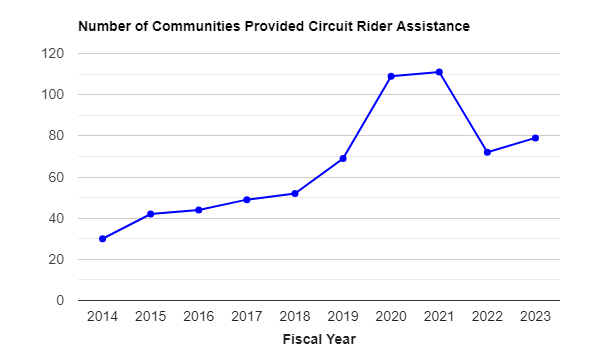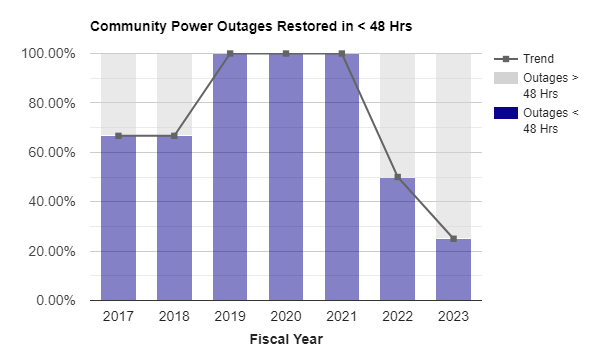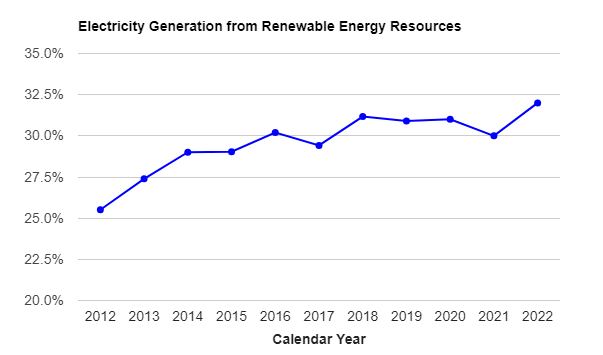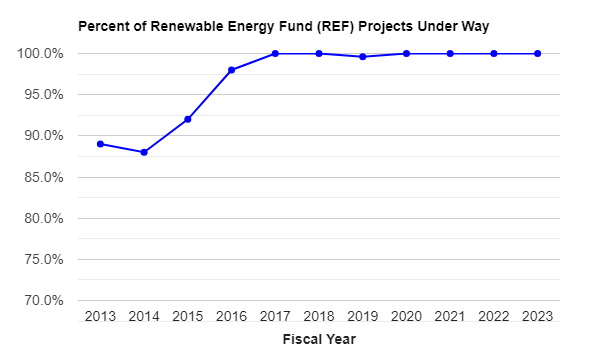Performance Details
Department of Commerce, Community, and Economic Development - Alaska Energy Authority
Mission
Reduce the cost of energy in Alaska.
Core Services
- Management and development of Alaska Energy Authority-owned infrastructure.
- Assist communities and utilities in the development, financing, construction, and ongoing technical support of cost-effective energy projects.
- Reduce the cost of electricity for residential customers and community facilities in rural Alaska through the management of the Power Cost Equalization program.
- Increase the safety, reliability, and efficiency of community energy systems through assistance and training.
- Lead and coordinate state energy policy and planning.
|
|
Core Services |
|||||||||||||||||||
|
|
Performance Detail
| A: Result -The cost of energy in Alaska is reduced. |
| A1: Core Service - Management and development of Alaska Energy Authority-owned infrastructure. |
Target #2: Manage the Alaska Intertie for the benefit of Railbelt Consumers..
The Alaska Intertie allows Golden Valley Electric Association (GVEA) in Fairbanks to purchase electricity produced less expensively with lower-cost energy, such as natural gas and hydroelectric from the Anchorage and Kenai Peninsula utilities. This results in savings for GVEA consumers. GVEA"s avoided costs have increased in recent years due to a lack of economic energy from Southcentral. They expect those avoided costs to decrease in the future as GVEA concludes longer-term gas contracts to be supplied to Southcentral power plants for GVEA benefit, and renewable energy resources are developed on the Railbelt. In FY2024 GVEA is expected to decommission the Healy Coal Plant Unit 2, which will require additional energy sales from Southcentral. Target Last Modified: 11/14/2023 |
Target #3: No unplanned outages occurred on the Alaska Intertie..
Target Last Modified: 03/29/2023 |
| A2: Core Service - Assist communities and utilities in the development, financing, construction, and ongoing technical support of cost-effective energy projects. |
Target #1: 100 percent of Bulk Fuel Upgrade (BFU) projects completed..
Bringing facilities into compliance with federal and state codes and regulations also makes them safer and more reliable. By eliminating fuel spills from leaking tanks, a community can use all fuel purchased and avoid environmental cleanup costs. In following business plan terms, owner-operators are better able to manage the storage facilities and the fuel inventories to the greatest economic advantage. The chart above indicates the continuous progress toward the goal. Projects flow from the left side of the graph to the right, as they are identified as a project in need, then progress from conceptual design through construction, and are ultimately completed. AEA is moving away from full projects and focusing heavily on the Bulk Fuel Maintenance and Improvement (M&I) program. A new tank farm may run $5-8 million dollars. With the Bulk Fuel M&I program, AEA can determine needed repairs and can offer a portion of the funds to perform the work. These projects typically result in a significant match from the community. At a minimum, each community has a list of maintenance projects, approximate cost, and priority for each project. Target Last Modified: 11/27/2023 |
Target #2: 100 percent of communities needing rural power system upgrades (RPSU) receive them..
At peak demand times the largest generator provides the power, while at low-demand times, or times renewable sources are generating, a smaller generator may provide the power. AEA has also increased fuel efficiency by adding electronic fuel injectors and we have strengthened many other components to ensure reliability and long life. AEA has installed remote monitoring systems to improve the capacity to provide remote technical assistance. The graphic above indicates the continuous progress toward the goal. Projects flow from the left side of the graph to the right as they are identified as a project in need, then progress from conceptual design through construction and are ultimately completed. The total number of projects varies due to many factors, such as changing community populations affecting eligibility for the RPSU program, and new needs arising. AEA is moving away from full projects and focusing heavily on Maintenance and Improvement for RPSU. Construction costs continue to rise. Power plants and tank farms that were installed by AEA 15-25 years ago are in good condition, but suffering from deferred maintenance and the need for upgraded technology. AEA has started reviewing the needs of a specific location to see if they need replacement, or if maintenance would extend the useful life of the infrastructure. AEA has been using the Diesel Emission Reduction Act (DERA) to replace diesel gensets in rural powerhouses and at times, matching the sites with the RPSU Maintenance and Improvement program, currently focused on upgrading the control systems (PLC, generator controls, meters, etc.). These improvements will result in a 10-15 year life extension of the existing control systems. AEA is also repairing minor systems in the power plant where possible. Target Last Modified: 11/27/2023 |
Target #3: Power Project Fund (PPF) outstanding balance increases annually..
From FY2014 to FY2022, the outstanding loan balance has continued to increase to a balance of $27.5 million at the end of FY2022. From FY2022 to FY2023, the outstanding loan balance has remained steady, with $27 million at the end of FY2023. The graph also shows the loan receivable since FY2013, which were $5.9 million. At a recorded $27 million for loan receivables for FY2023, this calculates as an almost 4.5x increase over the 10 years from FY2014 to FY2023. For FY2023, there was a combined total outstanding loan balance and undisbursed loan commitments of $33.9 million. FY2023 reflects a lower combined total outstanding loan balance and undisbursed loan commitments than FY2022, due to an undisbursed loan commitment of $4.9 million for financial assistance in development of a 6 mega-watt Solar Farm. As a robust, low-interest loan program, the PPF provides an advantageous financing tool for eligible borrowers to finance projects including but not limited to the repair and replacement of existing infrastructure for the development of new generation resources. An added benefit of the PPF loan program is its unique ability to offer such low-interest financing for both preliminary and later-stage projects, which generally proves difficult when pursuing traditional lending options. AEA is experiencing an increased interest in the PPF fund with the clean energy tax provisions and federal grant opportunities incentivizing development of renewable energy projects around the State. Clean energy projects that meet wage and domestic content requirements are eligible for up to 40 percent of eligible project costs in tax credits. Certain projects in communities identified as energy communities and low income or disadvantaged communities are eligible for up to 70 percent of project costs in tax credits. The Inflation Reduction Act authorized Elective Pay provisions allowing entities otherwise not eligible for tax credits, due to be tax exempt such as States and local governments, to be able to claim certain tax credits for the first time. The United States Department of Agriculture is offering loans with up to 60 percent loan forgiveness for qualifying clean energy projects and grants for up to 50 percent of eligible project costs for small businesses and electric cooperatives. The uncommitted cash balance less loan amounts requested in applications pending review is approximately $304,000 for the PPF loan program. The current cash balance is inadequate for pending loan applications. Loans are a primary funding source for the development of renewable energy projects, and as required cost matching for many available federal programs which require the leveraging of local and private investment, including the realization of federal tax credits as made available via the Inflation Reduction Act. Capitalization of this fund is needed to meet the increase in loan applications. Target Last Modified: 11/27/2023 |
| A3: Core Service - Reduce the cost of electricity for residential customers and community facilities in rural Alaska through the management of the Power Cost Equalization program. |
Target #1: 100 percent of eligible electric utilities receive Power Cost Equalization (PCE) payments..
PCE payments reduce the unit cost of power to residential and community facility customers of eligible utilities. AEA calculates and issues the payments, and provides technical assistance to utility clerks who need help preparing PCE reports. Utilities not participating in the PCE program do not receive payments. Target Last Modified: 11/27/2023 |
Target #2: Maximize each utility"s Power Cost Equalization (PCE) benefits to 100 percent of eligibility..
The graph above shows the number of PCE "eligible" residential kilowatt-hours (kWhs) sold as a percentage of the total residential kilowatt-hours (kWhs) sold. Effective FY2023, residential customers are eligible for PCE credit up to 750 kWhs per month per customer. Customers must pay the utility the full rate for all kWhs used more than those eligible for PCE. The average monthly residential kWhs consumed in FY2022 was 344 kWh per household. The statistical report FY2023 will be finalized by March 1, 2024. Consumption of electricity by eligible residential customers has seen a steady decrease over time, as residential customers continue to conserve and as certain communities avail themselves of the benefits of renewable energy power generation. Target Last Modified: 11/14/2023 |
| A4: Core Service - Increase the safety, reliability, and efficiency of community energy systems through assistance and training. |
Target #1: Circuit Rider assistance is provided to eligible communities..
As reflected in the graph AEA Circuit Rider Personnel have made a concerted effort to increase the frequency of remote instances of technical assistance. Many utilities are highly functional and do not request or demonstrate a need for assistance. Others may require and request assistance multiple times throughout the year. Circuit Rider assistance is provided in telephonic and local onsite support. AEA also uses the opportunity provided by onsite Circuit Rider assistance to conduct itinerant training relevant to the utility"s specific infrastructure. Target Last Modified: 11/27/2023 |
Target #2: Restore power to communities experiencing electrical emergencies within 48 hours..
AEA"s goal is to reach each community in need within 48 hours. In FY2023, four communities experienced an outage of more than two days. Two of these outages were due to unprecedented river ice jam flooding. Two additional outages were due to poor operations and maintenance By responding quickly, the potential damage is significantly reduced. The logistics and weather of rural Alaska are significant factors that can delay a response. Establishing good communication pathways with the utilities, providing ongoing operator training, and having a strong relationship with Alaska Emergency Management is key to reducing the time needed to respond and restore power. The increase in emergency responses is due largely to ongoing deferred maintenance and operations by local utilities. Target Last Modified: 11/27/2023 |
Target #3: All rural utilities (electric and bulk fuel) have appropriately trained operators and clerks..
AEA, in partnership with the Alaska Vocational Technical Education Center (AVTEC), changed how the power plant operator training is performed due to the COVID-19 pandemic. Students now participate via Zoom for six weeks and then have a two-week lab in person at the Alaska Vocational Technical Center, reducing program costs and improving participation. Proper maintenance and operation of energy infrastructure help ensure that the infrastructure continues to operate most efficiently and extends the facility"s operational life. Training in FY2023 included bulk fuel operator training, power plant operator training, person-in-charge training, utility management training, and PCE clerk training. Target Last Modified: 11/27/2023 |
| A5: Core Service - Lead and coordinate state energy policy and planning. |
Target #1: By 2025, 50 percent of electricity generation is from renewable sources..
The percentage of electrical needs met by renewable generation has increased from 25 percent in 2013 to an estimated 32 percent in 2022. Of the renewable generation, about 91 percent is produced by hydropower, seven percent by wind power, and two percent by other renewable sources (e.g. biomass and solar). Since so much renewable generation comes from hydropower, there are year-to-year fluctuations in overall renewable contribution based on weather. In years with little snow and low precipitation, there will be a decrease in total renewable generation with no change in installed capacity. The estimated percentage of total renewable generation in 2022 increased approximately 13 percent from 2021. Total generation declined by about one and a half percent. The intermittent-generation nature of renewables does contribute to such small variances in renewable-based generation for any given reporting year. In addition to the long-term gains in electricity generation from renewable energy depicted in the graph above, the REF grant program has also funded renewable energy systems in rural locations whose utilities are not required to report to the Energy Information Administration. REF projects also provided gains in renewable heat energy, such as biomass and heat recovery. Heat recovery projects typically displace costly heating fuel in schools, water systems, and other community facilities located in relative proximity to the powerhouse. Biomass projects displace heating fuel in non-residential buildings and bring energy security through local sourcing, as well as job creation at the local level. For Round 15 of the REF, 18 applications further expanding the integration of renewable generation within Alaska"s statewide energy portfolio were recommended to the Legislature. All 18 applications were approved and authorized by the Legislature and the Governor in June 2023. AEA is currently evaluating those applications for Round 16, with funding recommendations to submit upon conference with the Renewable Energy Fund Advisory Committee within the first 10 days of the 2024 legislative session. Increasing the percentage of electricity generated from renewable sources has been achieved by the following action items: • Local, regional, and statewide energy planning efforts that emphasize the need for data-driven decision making and use of most cost-effective, locally available resources; • REF projects; • Private capital in conjunction with REF grant money; • Additional state appropriations for renewable energy projects; • PPF loan program support of renewable energy projects; • Recapitalization of PPF loan program to support additional projects; • Federal funding of renewable energy projects, including the Denali Commission, the Department of Energy, and the United States Department of Agriculture, including but not limited to those funding opportunities made available through the Infrastructure Investment and Jobs Act and the Inflation Reduction Act; • Upgrading transmission infrastructure to increase power delivery efficiency and eliminating transmission capacity constraints within those electric grids, which benefit from the availability of renewable generation sources; • Energy efficiency and conservation programs such as AEA"s Village Energy Efficiency Program, the Commercial Building Energy Audit Program, and public education and outreach activities that lower overall energy consumption, thereby increasing the percentage of power generated by renewables; and • The addition of the West Fork Upper Battle Creek Diversion to Bradley Lake has increased renewables on the Railbelt by 37,000 megawatt-hours, which is equivalent to the annual electrical usage of approximately 5,000 homes. AEA is further exploring the Dixon Diversion project which, like the Battle Creek project, will add additional water to the Bradley Lake hydro reservoir for added hydro generation, increasing the annual energy production of Bradley Lake by 50%, or the equivalent of 14,000-28,000 homes. Target Last Modified: 11/27/2023 |
Target #2: 100 percent of Renewable Energy Fund (REF) projects are underway..
REF is a unique and robust competitive grant program, which provides critical financial assistance for statewide renewable energy projects, across a variety of project phases. Since its inception in 2008, the REF program has secured approximately $317 million in State funds and leveraged over $300 million in federal and local funds toward renewable energy development across a variety of project phases throughout Alaska. Nearly 300 renewable energy projects are part of the REF catalog. There are 60 REF projects currently under development. A recent third-party impact analysis of the REF program estimates that approximately 85 million gallons of diesel and 2.2 million cubic feet of natural gas have been displaced through 2022 by over 100 fully operational REF projects. In FY2024, AEA received $17 million from the Alaska Legislature in support of 18 recommended REF Round 15 projects. AEA has received 28 applications as of the deadline for REF Round 16, yielding a total request of $37.8 million. Target Last Modified: 11/27/2023 |
Last refreshed: 04/17/2024 05:00 pm


